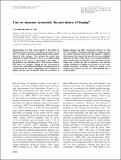Can we accurately measure the prevalence of doping?

Type de référence
Date
2011Langue de la référence
AnglaisEntité(s) de recherche
Résumé
Questionnaires are used in the majority of the studies on doping prevalence in sport. Nevertheless, prevalence is not easy to evaluate and previous epidemiologic studies demonstrated a wide variance. This variance has mostly been explained by sample differences. The way to evaluate doping prevalence in the survey is questioned in this paper. A questionnaire was administered to 1810 amateur athletes (993 males, 817 females). Doping use was ascertained in various ways, using different definitions of doping and types of question in the survey. Depending on the definition of doping and the type of question used, the prevalence of doping obtained can differ enormously, between 1.3 and 39.2% of athletes. Marijuana and drugs for asthma were the two banned substances most used. The majority of athletes often ignored the banned list and did not use prohibited substances to dope. Using various ways to question athletes, observing the usage of substances, cross checking the data, taking into account the aim of substances uses and the various definitions of doping are necessary to give more reliable prevalence of doping. Moreover, doping at an amateur level seems to be less of a sport problem than a social problem.Titre du périodique
Scandinavian Journal of Medicine and Science in SportsMaison d’édition
Wiley-Blackwell Publ.Pays d'édition
Grande-Bretagnep-ISSN
0905-7188e-ISSN
1600-0838Volume / tome
21Pagination
132-142URL permanente ORFEE
http://hdl.handle.net/20.500.12162/157Autre(s) URL(s) permanente(s)
http://doi.org/10.1111/j.1600-0838 2010.01199xLa publication existe uniquement sous forme électronique
ouiDocument(s) associé(s) à la référence
Texte intégral :
Fichier
Accès
Commentaire
Version
Taille
Sur demande
postprint éditeur
140.0ko
Ouvert
postprint auteur
314.1ko
- Tout ORFEE
- Détail référence



